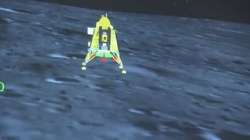Chandrayaan-3 Moon landing draws over 9.1 million online viewers
Although official television viewership numbers have not been released, the YouTube link of the channel received an audience of more than 750,822 when the Chandrayaan-3 Vikram lander successfully landed on the Moon.

The Indian Space Research Organisation (ISRO) has achieved a significant milestone as the Chandrayaan-3 mission successfully touched down on the Moon's surface after a 40-day journey from the Sathish Dhawan Space Centre in Sriharikota. Reportedly, the Chandrayaan-3 mission garnered widespread attention, with over 80,59,688 viewers tuning in to witness the feat live. On Facebook, more than 355.6K people were connected when the lander made contact with the lunar surface.
This achievement marks India's third lunar mission and showcases the nation's remarkable progress in space exploration. Numerous viewers from India and around the world tuned in to watch the historic moment unfold. In India, Doordarshan TV took on the role of the official broadcaster for this pivotal occasion.
ALSO READ | Chandrayaan-3: Vikram Lander sends first image of Moon after successful landing
While official television viewership numbers are yet to be released, the channel's YouTube link attracted an audience of over 750,822 when the Chandrayaan-3 Vikram lander successfully landed on the Moon.
The Chandrayaan-3 mission follows in the footsteps of the 2019 Chandrayaan-2 mission, which experienced an unfortunate conclusion when the Vikram lander crashed during landing.
ALSO READ | Chandrayaan-3 successfully lands on Moon's south pole, India first country to achieve this feat
Notably, the Chandrayaan-3 mission is hailed as one of the most cost-effective space endeavors, with an estimated budget of Rs 615 crore. In comparison, its predecessor, Chandrayaan-2, launched on July 22, 2019, was executed at a cost of Rs 978 crore.
This budget included Rs 603 crore for components such as the orbiter, lander, rover, navigation, and ground support network, along with Rs 375 crore for the indigenous GSLV rocket equipped with a cryogenic engine.